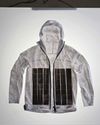
LIVING BRIDGES
Army ants in huge raiding columns will deploy their own bodies to form living bridges so fellow workers can cross gaps quickly. A bridge consists of up to 50 ants and a colony may have 40 or 50 bridges in use at any time. Myrmecologists (people who study ants) at the New Jersey Institute of Technology's Swarm Lab have worked out a simple rule governing this behaviour. Ants only stay in a bridge if they feel sufficient numbers of other ants scurrying over their backs. To justify investing that much labour, the shortcut has to be popular. If fewer ants cross, forming a bridge isn't worth the effort - it's better for the colony if these ants go around the obstacle the long way.
IT'S A WRAP
In 2010, countless trees were left shrouded in swathes of silk in Pakistan following monsoon rains. It's thought that the flood waters forced millions of spiders to take refuge in the trees, where they spun these veil-like webs. Though the identity of the spiders in this image is not known, some species will congregate in composite webs, often resembling huge hammocks or sheets. Spiders live alone as a rule, but some - most of which are small and occur in the tropics - exhibit varying degrees of social behaviour. Communal webs enable them to catch much bigger prey and share the energy-sapping tasks of spinning the webs and maintaining their structure. Occasionally, enormous megawebs appear, covering several hundred square metres in silk, perhaps because a superabundance of prey caused an explosion in the local spider population.
WHEELS OF FORTUNE
Bu hikaye BBC Science Focus dergisinin August 2022 sayısından alınmıştır.
Start your 7-day Magzter GOLD free trial to access thousands of curated premium stories, and 9,000+ magazines and newspapers.
Already a subscriber ? Giriş Yap
Bu hikaye BBC Science Focus dergisinin August 2022 sayısından alınmıştır.
Start your 7-day Magzter GOLD free trial to access thousands of curated premium stories, and 9,000+ magazines and newspapers.
Already a subscriber? Giriş Yap

NOW YOU SEE ME, NOW YOU DON'T
Scientists around the world are working on ways to hide us from sight. But how close are we to developing tech that could make us invisible?

UNCORKED POTENTIAL
How much good can ditching drink for a month really do? Answer: a whole lot. In fact, science shows even short-term abstinence could unlock a cocktail of lasting benefits

Scientists discover when humans and dogs became friends
The relationship spans thousands of years, but experts might have pinpointed the first connection

Why it's so hard to kick a gambling addiction
We now know that gambling can be as addictive as drugs, but there are factors that can make it even harder to quit

How much could Ozempic change our world?
The weight-loss drug has made headlines and broken sales records, but what does it mean for our future?

WHY DOES DRINKING ALCOHOL MAKE IT SO MUCH HARDER TO LOSE WEIGHT?
While enjoying the occasional glass of wine or pint of beer may seem harmless, regular or excessive alcohol consumption can significantly hinder your weight-loss journey for a few reasons:

Why do so many New Year's resolutions fail?
Establishing positive new habits is hard at any time of year. But there are ways to stop your attempts ending in failure

'Extreme' solar radiation storm could hit Earth
Sun-like stars may have tantrums far more frequently than we thought

HOW CAN I BANISH THE JANUARY BLUES?
Dark mornings, long chilly evenings and short days; many people find January tough.

Neutrinos are getting in the way of dark matter detection
These troublesome particles are difficult to detect, but they're starting to show up in places where they're not wanted